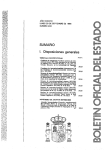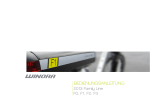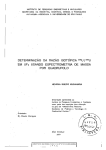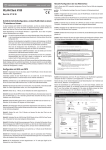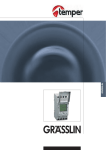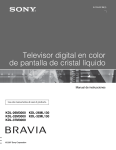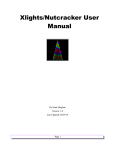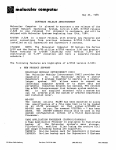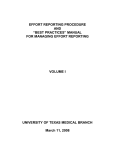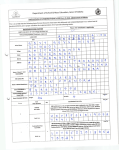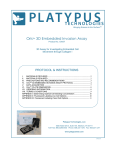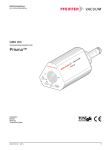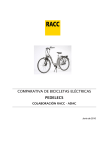Download Mass analyzer system for the direct determination of organic
Transcript
United States Patent [191 [11] Patent Number: Korte et a1. [45] [54] MASS ANALYZER SYSTEM FOR THE DIRECT DETERMINATION OF QRGANIC 3,187,179 6/1965 Craig et al. ....................... .. 250/289 3,700,893 10/1972 Seidenberg et al. . 250/289 COMPOUNDS IN PPB AND HIGH PPT 4,442,353 4/ 1984 Baubron ....... .. CONCENTRATIONS IN THE GAS PHASE 4,672,203 6/1987 Holkeboer ........................ .. 250/289 . : ' Ahm , [57] Alamogordo’ N‘ Mex‘ Coulston International Corporation, A single-stage uadrupole mass analyzer is rovided with a highly sensitive electron multipller, a turbomo Albany, NY. lecular pump, and a mass correction lens placed be , u [51] q I I u - p lar pump. These components are arranged and selected to provide a substantial increase in sensitivity permitting the direct analysis of organic compounds in the gas phase in the ppb and high ppt concentration range. The f S N er‘ 840 496 M 0' ’ ’ 17 at‘ placement of the mass correction lens and the area of its ’ Foreign Application Priority Data Mar 22 1985 [DE] ' ABSTRACT tween the quadrupole sensor unit and the turbomolecu ggnnuahon'm'pm 0 ' [30] . Germany; Frederick Coulston, Related US. Application Data [ 1 . 250/283 . [21] Appl‘ No" 910’371 [22] Filed: Sep. 22, 1986 _ Jul. 12, 1988 Attorney, Agent, orFirm-Leyd1g, Voit & Mayer H. . 63 Date of Patent: Primary Examiner-Bruce C. Anderson [75] Inventors ggltildgglztggrlzier’chenjged' gzgaro’f [73] Assignee: 4,757,198 aperture has a pronounced effect on the detection limit, the optimum aperture area is a function of the mass of the molecules to be detected, and preferably an iris Fed. Rep. of Germany ..... .. 3510378 ’ diaphragm is used t° Permit manual °f aummatic adjust‘ ment of the aperture area to a predetermined optimum Int. Cit‘ ............................................ .. B011) 59/44 for each of the different substances to be detected_ Pref [52] US. Cl. ........................ .. 250/288; 250/282; erably the electron multiplier voltage is also variably 250/289 selected and reset during the scanning of each fragment [58] Field Of Search .............. .. 250/281, 232, 238, 289 [56] ‘ References Cited ion to optimize the signal-to-noise ratio of the electron mutiplier. The mass analyzer is sufficiently compact and economical to provide on-site analysis and the continu ous monitoring or control of industrial processes. U's- PATENT DOCUMENTS 2,610,300 9/1952 Walton et a1. .................... .. 250/288 2,714,164 7/1955 Riggle et al. ...................... .. 250/289 7. _ _ _ _ _ _ _ _ _ 20 Claims, 6 Drawing Sheets ._ j Z (arr/e04 f 0/474 6'75'7'5/14 (Al/(‘??t‘OJ/P?ff?) ' / ream/gm | I .rmzew I i i ), /; I | ale-aria” MVLT/PZ/Q? Le- ~44 | I I I I I __l I I _l N I I I | tam/72041451: SAMBA/#6‘ I MAM/v10 I I_ _ _ /7 _ _ _ _ _ _ _ _ _ _ _ _ I __ .I 2 Eff/"£154 MJLILW'Q’QQ US. Patent Jul. 12,1988 Sheet 1 of6 4,757,198 W1\\ .QkN J_wQNRQXI§NVIKQE§|1liI US. Patent Jul. 12, 1988 Sheet 4 bis 4,757,198 wtN _ WW US. Patent Jul. 12, 1988 F/G. 9 Sheet 6 of6 4,757,198 4,757,198 1 2 Another object of the invention is to provide a quad rupole mass analyzer of increased sensitivity with a MASS ANALYZER SYSTEM FOR THE DIRECT more efficient device for transferring samples to the DETERMINATION OF ORGANIC COMPOUNDS detector of the analyzer. IN PPB AND HIGH PPT CONCENTRATIONS IN Yet another object of the invention is to provide an 5 THE GAS PHASE economical and portable mass analyzer of increased sensitivity for on-site sampling and continuous monitor RELATED APPLICATIONS ing of industrial processes. The present application is a continuation-in-part of Brie?y,'in accordance with a primary aspect of the Us. application Ser. No. 840,496 ?led Mar. 17, 1986. 10 invention, the method comprises transferring organic BACKGROUND OF THE INVENTION 1. Field of the Invention The invention relates generally to the ?eld of mass analysis. The invention more speci?cally relates to a method and apparatus for gas-phase analysis of organic compounds at low concentrations in test samples. 2. Description of the Prior Art As is generally well known, problems associated with substances from a storage vessel or reservoir at high pressure through a metering device into a quadrupole mass analyzer at low pressure, decreasing the concen tration of the substances by evacuating the mass analy zer to pressures below usual operating conditions, and detecting the substances with a quadrupole mass analy zer of increased sensitivity. A quadrupole mass analyzer is provided with a nee dle valve to permit the introduction of the sample into mass analyzers limit the range of concentrations over 20 the vacuum chamber of the analyzer, an ion pump for which organic compounds can be detected and ana obtaining a reduced pressure in the vacuum chamber, lyzed in the gas phase. Test samples usually must be concentrated in an enrichment step prior to analysis. and a secondary electron multiplier for providing in creased sensitivity. Because complicated procedures for taking the sample Preferably the test sample passes directly through a and concentrating it cannot be standardized, consider 25 separator system of needle valves from a vacuum cou able deviation and error in measurement occur. Consid trollable sampling manifold to a modi?ed quadrupole erable amounts of the test sample are lost by the use of mass analyzer, the secondary electron multiplier is a gas sampling devices such as gas syringes for transfer of Channeltron ® electron multiplier, and a turbomolecu the concentrated sample to the analyzer. Additionally, lar pump used during mass analysis is combined with a gas phase reactions continue during transfer of the sam 30 mass correction lens. These modi?cations to the system ple to the analyzer, further impairing the analysis. Very reduced background noise such that organic com rarely is the detector satisfactorily combined with the pounds could be detected and concentration deter sampling or reaction volume, and in such cases the mined in the range of from ppb to high ppt in the gas systems are based on special spectroscopic methods. phase using direct mass spectroscopical analysis with Conventional mass analyzers cannot be used for the 35 out preliminary enrichment procedures. direct detection and measurement of organic com pounds in ppb concentrations. The low signal-to-noise ratio at regular pressures of 10-4 to 10-6 torr prevents It has been found that the location and orientation of the gas inlet and outlet to the quadrupole mass sensing unit, and speci?cally the placement and aperture of the analysis in the ppb range. A straight increase in the mass correction lens, have a critical effect on the detec vacuum reduces the concentration of the chemicals 40 tion limit. Although the precise mechanism for the im below the detection limit. These conventional mass provement of the detection limit is not clearly under analyzers include single-stage magnet sector units, and stood at this time, it appears to be related to an ongoing more recently introduced single-stage quadrupole units. No practical device for directly analyzing chemicals in the gas phase in ppb concentrations was previously available which operated without a preliminary enrich ment (concentration) step. For a mass analyzer using a cleansing of the quadrupole sensing unit during analysis which preferentially increases the duration which the 45 molecules to be detected remain in the quadrupole sens ing unit and thereby increases their concentration in the sensing unit relative to the population of the back single-stage magnet sector to obtain the required resolu tion and sensitivity, a very large magnet is required, ground molecules. This hypothesis is supported by the approach is to use two or more stages of magnet sectors stances to be detected. discovery that there are respective optimum areas of the resulting in a very massive machine. An alternative 50 aperture of the mass correction lens for various sub In any event, the improved performance is surprising or quadrupole units in which the ?rst stage, in effect, in view of the fact that at low pressures the mean free provides a preliminary enrichment or concentration for path of the molecules is much greater than the physical the second step. Such multiple stage machines are more complicated and still tend to be physically large. Their 55 dimensions of the quadrupole sensing unit, and normal non-linearties were previously observed at pressures relatively large size and high cost generally preclude their use for on-site sampling or the continuous moni toring of industrial processes. above 1X 10-5 Torr. These normal non-linearities were attributed to the molecular collisional effects and were previously minimized by operating the ionizer of the BRIEF SUMMARY OF THE INVENTION The primary object of the invention is to provide a quadrupole unit at reduced electron emission current method and apparatus for analyzing chemicals in the gas phase at ppb and high ppt concentrations without a The effect of the aperture area of the mass correction lens and the variation of the optimum area for various preliminary concentration step. substances are so striking that, in accordance with an . settings. A speci?c object of the invention is to provide a 65 important aspect of the present invention, the mass correction lens is provided with means for variably single-stage quadrupole mass analyzer with increased selecting the area of the aperture for the specific sub sensitivity capable of detection even at pressures of 10-9 torr. stance to be detected. If the concentrations of a number 3 4,757,198 of substances of varying molecular weights are to be determined, the aperture area is preferably reset a num ber of times during the mass scanning process to use 4 FIG. 1 is a schematic drawing of an apparatus ac cording to a preferred embodiment of the invention including a vacuum controllable sampling manifold, and also showing an optimized mass analyzer, a special separator system, and a control and data system; FIG. 2 is a detailed drawing of the special separator respective optimum values when scanning the fragment ions for the different substances. During operation of the mass analyzer with the mass found that the noise level or baseline of the Channel system; FIG. 3 is a schematic drawing of the internal con tron ® electron multiplier deviated from its optimum struction of the quadrupole mass spectrometer unit correction lens having an optimum aperture area, it was including the electron multiplier; minimum level as a function of the mass of the ions to be FIG. 4 is a schematic diagram of the mass ?lter in the detected. In accordance with another aspect of the quadrupole unit of FIG. 3; FIG. 5 shows respective graphs of the relative ion present invention, the operating characteristics of the Channeltron ® are readjusted for the detection of ions current intensities for benzene and trichloroethylene as of different mass. In particular, the value of the high voltage supplied to the Channeltron ® for effecting 15 a function of the area of the aperture in the mass correc tion lens; electron multiplication is variably selected as a function of ion mass. This variable selection of the voltage sup FIG. 6 is a schematic drawing of a control mecha nism for automatic adjustment of the aperture of the plied to the Channeltron® preferably is coordinated with automatic selection of the altenuator gain in the electrometer responsive to the direct Channeltron® output, so that the dynamic range of sensing the ion 20 mass correction lens; FIG. 7 is a schematic drawing of the optimized mass analyzer of FIG. 1 after the installation of the automatic control mechanism of FIG. 6 and an automatic control current of the selected mass is not exceeded. Associated for variably selecting the operating voltage of the elec with prestored Channeltron ® voltage control settings tron multiplier; are corresponding gain factors, and therefore the actual ion current is readily computed from the digitized elec FIG. 8 is a front elevation view of the optimized mass analyzer and microcomputer of FIG. I mounted on a trometer output value, the prestored gain factor having cart to provide on-site sampling; and been set for the mass being analyzed, and the electrome FIG. 9 is a rear elevation view of the system of FIG. ter altenuator gain having been automatically reset, if 1 drawn to scale to illustrate the arrangement of the necessary, to avoid limiting of the electrometer output 30 quadrupole sensor unit with respect to the sample inlet, in the event of a high ion concentration at the mass ion pump, mass correction lens, and turbomolecular pump. While the invention is susceptible to various modifi selected for analysis. Accordingly, this invention is useful for a variety of applications requiring the measurement of ppb and high cations and alternative forms, specific embodiments ppt concentrations of chemicals. The invention was 35 thereof have been shown by way of example in the used for the determination of work place concentrations drawings and will herein be described in detail. It of chemicals in production units (e.g. benzene and l,2-= should be understood, however, that it is not intended transdichloroethylene, detection limit: 100-500 ppt), to limit the invention to the particular forms disclosed, indoor concentration of chemicals of homes, of?ces etc. but on the contrary, the intention is to cover all modifi (pentachloro phenol, detection limit: 40-55 pg/m3), analysis of water and soil samples (benzene from water, detection limit: 10 ppb, CO2 from sand, detection limit: 100 ppt), determination of the photostability of organic compounds, determination of toxic compounds in inha lation chambers (acetylacetone, benzene, tetra chloromethane, freons 11 and 12, benzaldehyde, chloro benzene, 1,2 transdichloreothylene, detection limit: 100-500 ppt). Also the invention can be used for the 40 cations, equivalents and alternatives falling within the spirit and scope of the invention as de?ned by the ap pended claims. 45 DETAILED DESCRIPTION OF THE PREFERRED EMBODIMENT Turning now to FIGS. 1 and 2, there is shown a gas-phase mass analyzer system including a vacuum controllable sampling manifold 1 for obtaining a test sample in gaseous form, an optimized mass analyzer 2 ' determination of blood alcohol, of volatile compounds in urine, of chlorinated hydrocarbons in fat tissues, of 50 for detecting minute concentrations of molecules, a volatile products in sewage sludge, in slag of waste special separator system 3 for controlled transfer of gas incineration, and in fly ash, for the monitoring of atmo from the sampling manifold 1 to the mass analyzer 2, spheric concentrations of chemicals (pollutants such as and a control and data system 4, all of which are further NOx, S02, and organic environmental chemicals), of described below. exhaust fumes of internal combustion machines, for the 55 The sampling manifold 1 consists of a spherical reac indenti?cation and quanti?cation of industrial gas phase tor 5 with varying volumes of l-40O liters (0.3-110 g1.) reactions (e.g. NH3 synthesis), of thermal degradability and may include accessory devices for speci?c purposes of raw materials used in the semiconductor industry, for such as a lamp 6 for irradiation. The reactor 5 is the determination of gases such as hydrogen, helium, equipped with a heating mantle 7 allowing temperatures nitrogen and other gases in industry and for the moni~ 60 of up to 200° C. (400° F.). The entire system 1 is evacu toring of thermal decompositions of chemicals during ated by means of a turbomolecular pump 8 (e. g. Galileo combustion and pyrolysis. model PT-60) to a pressure of 10-8 torr. The exhaust of the turbomolecular pump 8 is removed by a fore pump BRIEF DESCRIPTION OF THE DRAWINGS 9 (e.g. Edwards model E2 M8). The reactor 5 can be Other objects and advantages of the invention will 65 separated from the pump system 8, 9 by a sliding valve become apparent upon reading the following detailed 9' with viton seals. description and upon reference to the drawings in In a typical mode of operation, solid or liquid samples which: are introduced into an inlet system 10. After achieving 5 4,757,198 the desired pressure in the inlet system 10, the samples or portions thereof become vaporized. The concentra tions in the gas phase can be determined by measuring the pressure. The inlet system 10 consists of a stainless steel casing with vacuum-tight sealable openings. A 6 10-6 torr and the concentrations of the chemicals to be examined are high. Valves 19 and 20 control the ?ow into the mass analyzer 2 in such a way that the neces sary levels for both pressure and concentration of the materials in the mass spectrometer are achieved. In case spring-loaded metal rod 11 serves to liberate mechani these operating parameters exist already in the manifold cally volatile samples kept in standardizable glass capil 1, the manifold 1 and mass analyzer system 2 can be connected directly via valve 18. A control and data system 4 (FIG. 1) uses a “Texas of solid samples. Placed underneath the inlet system 10, a commercially available combination of variable gas 0 Instruments Portable Professional” microcomputer for interpretation and storage of information about the state valves 12 (e.g. CJT-Vacuum-Technik, Ramelsbach) of the system. The microcomputer includes a TMS 9995 controls the ?ow of material into the reactor 5. The laries. Porcelain boats are available for the introduction microprocessor board (16-bit microprocessor with 8-bit sampling manifold 1 may be used at pressures within the data bus, 73 commands, 3.0 MHz system frequency, range of of l--10--8 torr and also works with variable 15 ?oppy disc control RS 232e, 64 K byte storage, double volumes of gas mixtures at variable pressures. Euroboard format), an RS 232 input board (single Euro The optimized mass analyzer system 2 consists of a board format), an input board (16 bit, single Euroboard quadrupole mass spectrometer unit 13 (UTI model l00c-02) including a Channeltron @ electron multiplier format), an output board (16 bit, single Euroboard for Operating and Service Manual”, Uthe Technology International, 325 North Mathilda Avenue, Sunnyvale, California 94086 (1979), which is incorporated by refer (12 bit resolution, single Euroboard format), a second D/A converter board (16 bit resolution, single Euro mat), a color video board (high resolution 512x512, 14. The quadrupole mass spectrometer unit 13 is further described in the “UTIlOOC Precision Mass Analyzer 20 single Euroboard format), a ?rst D/A converter board ence herein. The UTIlOOC unit 13 is sold along with a board format), an E-Bus back wall board (single Euro board format), a power supply (+5, +—l5 V with control unit (76 in FIG. 8) which enables manual opera overwattage protection and current limiter), a high tion and provides an interface for direct connection to a resolution color monitor, a system chassis, a VT-lOO standard microcomputer 4 which provides the control compatible keyboard, a dual-Floppy-Disk-DSDD, an interface cable for the UTI-l00c-02 quadrupole spec trometer 13, and a housing for the processor and moni and data system. Without the modi?cations described below, the UTI100C was found to have a detection 30 limit for nitrogen of 10-14 torr or 0.1 ppm. In accordance with an important aspect of the inven tor. - tion, the quadrupole unit 13 was further optimized by installing an ion pump 16 (e.g. Varian Vaciono 8 l/s) at a right angle, a mass analyzer-turbomolecular pump 17, The microcomputer was programmed to perform remote control of the UTI-l0OC-02 quadrupole spec trometer scanning and collection of the spectrometer data. The computer program is listed in the Append'nr to and a mass correction lens 15 installed at the inlet of the 35 the present speci?cation. turbomolecular pump. The mass correction lens is a. copper disc having an outer diameter of 48 mm, a thick ness of 2 mm, and an aperture of from about 20 mm to The microcomputer 4 transmits a precise voltage to the spectrometer 13 to select the mass of the ions which 45 mm which should be selected for the particular sub stance to be detected, as further described below. The exhaust of the turbomolecular pump 17 is eliminated by an associated fore pump 17’. are detected by the electron multiplier 14. This precise voltage is generated by a 16 bit digital-to-analog con verter having a 0—l0 V range, a dynamic impedance less than 1 kOhrn, noise level less than 1 mV, and drift less than 0.0005%, to insure a spectrometer resolution of 0.01 AMU. The microcomputer also has an output for The optimal functioning of the modi?ed system was selecting whether the electron multiplier is reading a evaluated according to the following criteria: (a) Tightness of the entire system was determined by 45 multiplied ion concentration signal or a non-multiplied Faraday cup signal received for determining the multi means of the time dependent increase of pressure allow plier gain by comparison of the two signals, and an ing a maximum leak rate of IX 10"5 torr l/s; and _ output activating an analog switch for feeding either the (b) Sensitivity measurements of the quadrupole spec— signal from the electron multiplier or the signal from a trometer 13 were made using benzene, acetylacetone pressure gauge to a twelve bit analog-to-digital con and chloroform, achieving a detection limit of at least verter for input to the microcomputer. In this fashion 100 ppb. the microcomputer can read the electron multiplier for By these improvements, the operating pressure of the ion current within the picoammeter range from 10"5 to mass analyzer was reduced to 10-9 torr, so that the 10-12 amperes, and the total pressure from 10-3 to background noise could not be measured any longer. Since the sensitivity increased enormously, the detec 55 10-8 torr. The ionizer filaments in the mass spectrome ter are automatically shut down in the event of extreme tion and determination of ppb and ppt concentrations of conditions such as loss of vacuum indicated by the elec chemicals was made possible. Since the background tron multiplier signal or the pressure gauge signal. could not be measured, spectras from pure samples were obtained. The microcomputer can therefore control the mass The separator system 3 is placed between manifold 1 60 spectrometer to scan any desired range or discrete points of the mass spectrum. The microcomputer has and mass analyzer system 2, and an optional selector also been programmed to present the spectrometer data valve 21 may be placed between the separator system 3 according to several standard formats; Scans are per and the sampling manifold 1 to obtain gas phase samples formed prior to analysis to characterize background from locations (not shown) other than the sampling noise as a function of total pressure and this pre-deter manifold 1. The separator system 3, further shown in mined background noise level is subtracted from the FIG. 2, consists of three needle valves 18-20 which can molecule or fragment ion concentration taking into be combined in parallel or in series. Usually valve 18 is account continuous total pressure monitoring during closed, i.e., the pressure in the manifold is higher than 7 4,757,198 8 analysis. The total pressure is continuously displayed on are determined by the mass analyzer system, the con the monitor. The molecule concentrations are also nor centrations are determined by measuring the pressure. malized taking into account the total pressure in order 5. Monitoring of inhalation experiments to display normalized line spectra on the monitor or to output the mass spectra to a printer as listings or Our analyzer can be used particularly well for the (graphic) matrix reproduction. The intensity of freely monitoring of toxicological inhalation studies, since selectable peaks can be monitored as a function of time. both the administered chemicals and the substances exhaled by the animal can be measured over any desired The peak intensity can be transmitted in serial RS 232 period of time. Acetylacetone, benzene, tetrachlorome thane, freons l1 and 12, benzaldehyde, chlorobenzene, format to a remote location. The microcomputer can perform speci?c peak-mode monitoring of a maximum of eight selected AMU peaks as a function of time. The spectra can be automatically calibrated for m/c+ and and 1,2-transdichloroethylene, for example, can be de their intensities. Quantitation is performed using both tected down to 100 to 500 ppt. Turning now to FIG. 3, there is shown a schematic second-order approximation and suitable calibration drawing of the internal components of the UTIlOOC substances (e.g. Freons, carbon tetrachloride, benzene, toluene). Moreover, speci?ed standard spectra can be stored using ?ve selected fragment ions. The following suggested applications illustrate the mass spectrometer unit 13. At the bottom is an ionizer 131 in which a thoriated irridium thermionic ?lament 132 emits electrons which are attracted to a cylindrical grid 133, pass through it, and form a negative space charge region 134 within the grid 133. Some of the electrons strike molecules in the gas sample, causing various ?elds of application for our mass analyzer sys~ tem, but they are in no way intended to limit the uses or ?elds to which this invention is capable of being ap them to ionize, and the ions are attracted to the negative plied: space charge region 134. The grid 134 is itself positive, causing ions to be emitted through a central aperture in a focus plate 136 and travel upward to the Channel l. Determination of work place concentrations of organic chemicals in production units tron ® electron multiplier 14. By means of our mass analyzer system, the concentra In order that ions of only a selected mass reach the tions of chemicals in factories and production units can be determined and controlled continuously. The opti mized analyzer system 2 with the separator system 3 is able to measure directly air samples taken at ambient Channeltron® 14, a mass filter generally designated 137 is interposed between the ionizer 131 and the Chan 30 neltron® 14. The mass ?lter 137 includes four pre cisely machined rods 138, two of which are charged positive (+V0), and the other of which are charged pressure. By using the separator 3 with the optional selector’valve 21 (FIG. 1), samples from different loca negative (—Vo), setting up a quadrupole electric ?eld tions can be taken. Since one spectrum only takes 10 139, as shown in FIG. 4. This quadrupole electric ?eld seconds, the time dependent work place concentration 139 has a value of zero on axis, and increases from zero at different locations can easily be determined and mon= itored. Also, acute maximum concentrations, which are as a function of the distance from the axis, tending to cause the ions to move away from the positive rods and toward the negative rods. But ions of a selected mass, or more precisely a selected mass to charge ratio, are di extremely important for the evaluation of work place safety, can be measured. Chemical concentrations of benzene and l,2~transdichloroethylene, for example, can be detected to 100-500 ppt. 2. Determination of indoor concentrations of chemicals Since the sensitivity of the described gas phase mass analyzer reaches the low ppb to high ppt level, the concentrations of pollutants in indoor areas, e.g. homes or of?ces, can easily be measured. Concentration/time 40 verted by an additional alternating potential (V lcoscot, V lsinwt) between the positive and negative rods, caus ing the selected ions to travel about the axis in a circular orbit, and thereby permitting them to travel to the Channeltron ® where they are detected as an ion cur 45 rent. A simpli?ed model of the operation of the mass ?lter assumes that the resonance condition of the selected ions results from a centripetal acceleration which is diagrams allow the elucidation of the actual indoor known from Newton’s law to be related to the electro exposure to pollutants. Pentachlorophenol, for exam~ ple, can be detected down to 40-55 pug/m3. 50 static force according to: 3. Analysis of aqueous and solid samples (studies of water and soil samples) After placing aqueous or solid samples into the inlet where m--, is the mass of the selected ion, r is the radius system 10, the volatile compounds are transferred into 55 of the centripetal motion about the central axis of the mass ?lter, a) is the angular frequency of the alternating the gas phase by the high vacuum and analyzed in the way described above. CO; from sand, for example, has potential (V lcoswt, Vlsinwt), q is the charge of the ion, been detected by means of our invention at 10 ppb, and and E, is the maximum radial component of the alternat ing electric ?eld at the radius r. The maximum radial component Er, however, is approximately a linear func tion of r, according to: the detection limit is about 100 ppt. 4. Determination of the photostability of organic compounds The material to be examined is placed on a suitable carrier (e.g. on a cold ?nger by dissolving the material, applying on the cold ?nger, and evaporating the solvent 65 where a is a constant distance on the order of the radius or placing the material directly on the cold ?nger, e.g. of the rods 138 from the central axis and which is re plastic foils) and irradiated by external light sources 6 lated to the diameter and spacing of the rods. By elimi with variable wave lengths. The volatile photoproducts 9 4,757,198 the resonance condition becomes independent of r, and the selected mass to charge ratio can be varied by ad In view of FIG. 5, it is advantageous to provide means for automatically selecting the aperture area justing V or to: during mass analysis to optimum areas for each com pound to be detected. For this purpose a photographic ' as. = L ‘1 10 ever, is about 42% of the area of a full opening (i.e., 'an internal diameter of about 29 mm). In each case the pressure during mass analysis was 2.2x 10--6 torr nating E, from the two equations above, it is seen that (1:202 iris diaphram was installed in lieu of the 2 mm thick copper disc mass correction lens (15 in FIG. 1). There 10 fore, the curves as shown in FIG. 2 can be obtained by ing (0 constant, to obtain a mass spectrum. continuously varying the area of the aperture and not This simpli?ed theory of operation does not take into account the effects of collisions between ions or ions ing the change in the ion current for a characteristic ion and molecules which might occur in the mass spectrom of a standard sample of the compound to be detected. eter unit 13 and tend to disturb the highly selective Preferably these tests are run for a number of different resonance condition. Although the low pressures in the compounds, and the optimum values are prestored in unit during mass analysis insures that intermolecular the memory of the microcomputer 4. Then, during collisions are infrequent, they are manifested by the analysis of a sample, they are recalled from memory for so-called normal non-linearities which appear at pres readjusting the aperture area before the scanning of sures greater than about 1><l0-5 torr These effects each of the respective fragment ion masses of interest. In practice it is most convenient to adjust V while hold have previously been minimized by operating the ther 20 Preferably the system is provided with automatic mionic ?lament 132 (FIG. 3) at reduced emission cur means for adjusting the aperture area of the mass cor rents. Apparently this reduces the normal non-linearties rection lens. A proposed device is shown in FIG. 6. The by reducing the ionization rate in the ionizer, so that iris diaphram 51 is mounted inside a two-part vacuum nonlinear effects caused by ion-ion interactions (such as housing 52 which is provided with studs 53 or holes for inter-ion collisions or the build-up of an ion space 25 attachment of the housing to the standard ?anged vac charge in the mass ?lter 137) are reduced. uum connections (e.g., see FIG. 8). A ring gear 54 Experimentation with the UTIlOOC, however, re mounted to the iris diaphram 51 is adjusted by a worm vealed that the placement and orientation of the inlet gear 55 attached to a control shaft 56 protruding from and pumps had a critical effect on the mass spectrome the housing 52 through a vacuum seal 57. A second ring ter’s detection limit. Apparently these factors affect the 30 gear 58 is attached to the control shaft 56 and is selec detection limit by preferentially affecting the ?ow of the background constituents (e.g., N2 in an air sample) tively rotated by a servomotor 59 via a worm gear 60 a central side port 75 (FIG. 3) in the UTIIOOC mass by a servo error ampli?er 62 responsive to a command for adjustment of the iris opening. The shaft of a multi relative to the ions to be detected, and also tend to tum potentiometer 61 is coupled to the control shaft 56 shield the highly sensitive Channeltron ® from interfer ence, which would otherwise be caused by the flow of 35 in order to sense the degree of opening of the iris dia phram 51. the sample toward rather than away from the Channel Ring gear 58, servomotor 59, worm gear 60, multi tron ® if the vacuum pumping system is kept on during tum potentiometer 61, and servo error ampli?er 62 are sensing to preferentially deplete the background con generally designated as regulator 32. centration. In order to provide automatic as well as manual ad In any event, it has been found that the detection limit 40 justment of the iris aperture, the servomotor is driven can be greatly increased by introducing the sample from signal on a line 63. The command signal is provided either by a manually set potentiometer 64, or by a digi ionizer end with a turbomolecular pump during mass analysis. Also, the ion pump (16 in FIG. 1) should be 45 tal-to-analog converter 35 driven by an output interface 36 coupled to the microcomputer 4, as selected by a used to reduce the partial pressure of the light mole switch 43. cules in the mass spectrometer unit 13 prior to the intro The optimized analyzer 2’ with the automatic aper duction of the sample, although it cannot be used during ture adjusting mechanism installed is shown in FIG. 7. the subsequent mass analysis of the sample since its power supply generates electrical interference with the 50 When the aperture 31 of the adjustable mass correction spectrometer unit 13, and evacuating the unit from its electrical signal from the Channeltron ® 14. Moreover, it is very advantageous to use the mass correction lens (15 in FIG. 1) at the inlet to the turbomolecular pump 17, and to select the area of the aperture in the lens in lens 15' is preset to a new area for a new substance as commanded by the computer 4, it is also desirable to automatically adjust the multiplier voltage of the Chan neltron ® electron multiplier 14 to preselected values which optimize the signal-to-noise ratio of the detection accordance with the mass of the molecules to be de 55 process for the ions corresponding to the substance. For tected. this purpose regulator 39 of the Channeltron ® power Turning now to FIG. 5, the criticality of the area of supply is controlled in response to a central signal. A the aperture of the mass correction lens is illustrated along with the dependance of the optimum aperture switch 40 is provided to obtain the control signal from tected. The relative intensity of the detected ions as a the output interface 36, or from a manually adjustable percentage of the maximum intensity is plotted as a function of the relative aperture area, in terms of the potentiometer 42. area as a function of mass of the molecules to be de 60 either another digital-to-analog converter 38 driven by Turning now to FIGS. 8 and 9, there is shown a scale drawing of a mobile version of the optimized mass ana opening having a 45 mm internal diameter. The opti 65 lyzer 2 of FIG. I mounted on a cart 70 having a frame of which is 32" high, 24" wide, and 32" deep. Instead of mum aperture area for benzene is about 54% of the area percentage of the maximum aperture area for a full -of a full opening (i.e., an internal diameter of 33 mm). The optimum aperture area for trichloroethylene, how the sampling valves of FIG. 2, there is provided a ?anged sample inlet 71, and a variable leak valve 72 4,757,198 11 12 (Series 203 by Granville-Phillips Co. of Boulder, Colo then the mass spectrometer 13 is switched on from the rado) having a digital readout 73 indicating a multitude UTI control console 76, thereby energizing the RF generator 77, the ionizer ?lament (132 in FIG. 3), and the high voltage supply to the Channeltron ® electron multiplier 14. The computer 4, and its associated printer of possible settings. To quickly shut off the inlet ?ow, an inlet valve 74 is placed in series between the variable leak valve 72 and an inlet pipe 75 attached to the UTIIOOC mass spectrometer unit 13. (See the back side 87, may be turned on at this time for automatic rather in FIG. 9). than manual control of the mass spectrum scanning. The controls for the system 2 are shown in FIG. 8 on the front of the cart. The mass spectrometer unit 13 is connected to the sample inlet 71. After checking the controlled by a UTI control console 76, which indicates numeric indicator 73 to ensure that the variable leak the ion mass being scanned in AMU and the vacuum in the spectrometer unit in torr. (The vacuum is sensed from the electrical conditions in the ionizer 131 in FIG. valve 72 is closed, the inlet valve '74 is opened. Then, the variable leak valve is slowly opened until a pressure 3). The alternating voltage for the mass filter (137 in FIG. 3) is provided by an RF generator 77 by the Uthe For analysis of a sample from a source, the source is of 10--6 to 10-7 torr is indicated on the control console 76. 15 Co., but it does not have any operator-adjusted con» trols. The control console 76 also provides the power At this time a constant stream of the substances to be analyzed is passing through the mass spectrometer 13 to the turbomolecular pump 17, and the mass analysis process may begin for scanning a range of mass values, or if scanning for determining the concentration of supplied to the Channeltron ®, which was supplied by the Uthe Co. The ion pump 16 is powered by an ion pump control unit 78. The ion pump is a Varion No. BL/S No. 911-505 with a magnet No. 911-0030, from known substances, the discrete mass values of the char— acteristic fragment ions of each substance. Although a Varion Co., 700 Stuttgart 8, Handwerk str. 5-7, West mass correction lens 15 having a ?xed aperture area is Germany. The ion pump control unit is part No. shown in FIG. 9, if the variable aperture lens 15' of 929-0062 supplied by Varion. _ V FIG. 6 were used, the aperture of the lens would prefer The turbomolecular pump 17' is‘ an "Ere-airman 25 ably be readjusted to an optimum area for each known model ETP63180 controlled by a control unit 90 model substance. The total intensity of each known substance No. CST-100 distributed by Vacuum Technik GMBH, to be determined is then obtained by a weighted aver= 8061 Ramelbach, Asbacherstr. 6, West Germany. The ' age of the measured currents of its fragment ions, the turbomolecular pump 17 is run continuously at 6,000 RPM and is cooled by a heat sink 79 and a fan 80. ‘ weighing factors being determined by the relative inten sities of the fragments obtained during analysis of a standard sample of the substance to be determined, with To prevent back?ow of lubricating oil mist, an in-line ?lter 84 (Model No. TX075 by MDC Vacuum Products Corp., 23842 Cabot Blvd., Haward, Calif. 94545) con ' appropriate correction for fragment ions which are common to more than one of the known substances. nects the turbomolecular pump 17 to its associated fore The scanning process with the analyzer 2 of FIGS. pump 17'. The fore pump 17’ is part No. ZM2004 sup 35 8-9 requires approximately 2 minutes for scanning a plied by Alcatel Co., 7 Ponds St., Hanover, Mass. mass spectrum ranging from 0 to 300 AMU. After scan ning is done, the ion pump 16 is turned back on. At night, the heat wrap 85 is turned on, for example, by a i diurnal timer, so that it will have baked out the system via rubber mounts 81, type SLM-l supplied by Barry 40 . at night and the system will have cooled to operating 92339» . r . ' . . To reduce vibration to the mass spectrometer unit 13, the turbomolecular pump 17 is mounted to the cart 70 Controls GmbH, D6096 Raunheim, West Germany. temperatures in the morning. The mass spectrometer unit is also more directly mounted to the top of the cart via rubber mounts 82 and a beam 83 which is clamped to the outer shell of the To service the ion pump 16 and the turbomolecular pump 17 without breaking vacuum to the spectrometer _ mass spectrometer unit 13. 1 unit 13, respective gate valves 88, 89 are provided for 455 manually closing off the connections of the pumps to In order to initially put the optimized mass analyzer ‘5 the spectrometer unit. The gate valves 88, 89 are Model i No. SVB 1.53 VM supplied by Torr Vac. Products, in a high vacuum state, the fore pump 17 ’ is turned on to pump the system down to a low vacuum. Then the ’ Van Nuys, Calif. In view of the above, an economical and portable mass analyzer has been described which uses a quadru turbomolecular pump is turned on until a higher vac-_ uum is obtained. The system is then “baked out” by turning on a “heat wrap” resistance heater 85 which is energized by a triac power control 86 to bring the mass spectrometer unit 13 up to between 200° C. to 320° C. The “heat wrap” 85 and triac control 86 are supplied by pole mass spectrometer of increased sensitivity. A high 1 sensitivity electron multiplier is used along with a mass , correction lens arranged with respect to a sample inlet 1 and a vacuum source so that the detection limit is CJT Vacuum, 8061 Ramelbach, Asbacherstr 6, West 55 greatly improved for the substances to be detected. Germany. After the system is suf?ciently baked out to Preferably the aperture area of the mass correction lens obtain a high vacuum (e.g., better than 10--8 torr), the is variably adjustable and is set to a perdetermined opti ion pump 16 is turned on to obtain an ultra-high vacuum mum area for each substance under analysis. It is also (e.g., better than 10-9 torr. Prior to analysis, power to the heat wrap 85 is turned off and the spectrometer unit is allowed to cool for preferred to adjust the electron multiplier high voltage value to a predetermined value for each ion mass to optimize the signal-to-noise ratio of detection. The about one to two and a half hours (depending on the small size and low cost of the mass analyzer enables it to bake-out temperature) to a ?nal temperature of 150° C. or lower. For analysis, the ion pump 16 is turned off and be used economically for onsite sampling and monitor ing or controlling industrial processes. 65 4,757,198 13 ~ 14 APPENDIX MASS SPECTROMETER CONTROL PROGRAM ‘FOR THE TEXAS INSTRUMENTS PROFESSIONAL COMPUTER BASIC VERSION 1. l0 ' ' copyright 1986 1L1$T ZRUN C . and Gesellschaft Fur Coulston Interna t'on-al l StrahTéE-Und Umweltforschung mbH 3LOAO" 4SAVE" SF'ILES (:CUNT 7, "LF’TI SLOCATE 9COLCIR IOF'ALET BKORNO Ok LOAD"OSF Ok LIST 5 KEY OFF 6 CLEAR 1O DIM LI'l-(303) 15 DIM PKSEL(16, 16) 2O DIM RANOED(13) 30 DIM AVALUE(301,3) 31 DIM X(300) .35 DIM TOP( 13) 45 OOSUB 3000 ’ INITILIZE 5O COLOR 2 6O LOCATE 1, 1O 9O GOTO 500 ’ MASTER MENU 500 REM aware-Mme SUBROUTINE MASTER MENU *<I**<I>-l********<lm***** 505 CLSI KEY OFF 510 LOCATE 3,23 515 COLOR O,2,0,64 520 PRINT “' ILIST 2RUN SLOAO" 4SAVE" SFILES 6CCINT 7, "LF'TI BLCICATE ‘E'COLC'R IOF'ALET 515 COLOR O,2,0,64 520 PRINT " S Y S T E M M E. N U "; 525 COLOR 6,0,0,0 530 LOCATE 6,5 535 PRINT'"F1 I Read Spectrum"; 540 LOCATE 8,5 545 PRINT "F2 I Save Spectrum"; 550 LOCATE 10,5 555 PRINT "F3 I Read - Total Pressure"; ' _ 560 LOCATE 12,5 565 PRINT "F4 I Display Background"; 570 LOCATE 14,5 , 575 PRINT "F5 I Time Scan"; 580 LOCATE 16,5 565 PRINT "F6 I Print Routines"; 590 LOCATE 6,40 59 T PRINT " F7 I Calibrate"; _'. LOCATE 8,40 605 PRINT " F8 I View Spectrum"; - 61*0 LOCATE 10,40 61: PRINT " F9 - Inn-i1 ize Diskette ", 620 LOCATE 12,40 625 PRINT "F10 =- Standby "; 625 PRINT "F10 I Standby "; ILIST 2RUN $1.0m)" 4SAVE" 5FILES 6CONT 615 PRINT -- p9 = Initil ize Diskette "; 620 625 PRINT LOCATE "F10 12, 40 = Standby "; 630 LOCATE 14, 4O _ ' ' ‘ 635 PRINT "F11 I Identify spectrum"; 640 LOCATE 16,40 645 PRINT "F12 I Exit to System": 650 LOCATE 24,40 655 COLOR 6,0 560 PRINT I‘ S'1ection ? ==>"; :PRINT CHR$(219) ; 565 REP‘ LOCATE 1, 1,0: PRINT 670 KEY 1 "A" 7,"LF‘T1 SLOCATE 900mm IOF'ALET 4,757,198 17 970 REM MN"!!- VIEW SPECTRUM 18 iiwi-awqmiia-l-qrwu-a 975 COLOR 7,0l LOCATE 24,57! PRINT "F8"; 977 OOSUB 10200 990 REM 1141"» INITILIZE DISKETTE “manta-041*!» 995 COLOR 7,0:LOCATE 24,57:PRINT "F9"; 996 GOSUB 9000 1LIST 2RUN 3LOAO" 4SAVE" SFILES bCONT 7, "LPT1 BLOCATE 9CIIILOR 1OPALET 1045 COLOR 7,0: LOCATE 24, 57=PRINT "F12"; 1050 CLS 1055 EN$=CHR$( 13) 1060 KEY 1, "LIST " 1065 1070 1075 1080 1085 1090 KEY KEY KEY KEY KEY KEY 2, "RUN"+EN$ 3, "LOAO"+CHR$(32)+CHR$(34) 4, "SAVE"+CHR$(32)+CHR$(34) 5, "F1LES"+EN$ 6, "CONT"+EN$ 7, ", "+CHR$(34)+"LPT1"‘ 1095 KEY 8, "LOCATE , , 1" 1100 1105 1110 1115 KEY 9, "COLOR 7,0,0,0"‘ KEY 10, "PALETTE" COLOR 7,0,0,0 KEY OFF 1120 SYSTEM 1500 OOSUB 11000" PRINT HEADER AND COLLECT VALUES 1735 OOSUB 8921 'LOAO AVALUE(X,0) HITH BACKGROUND 1740 FOR EIAST'ART TO AEND 1750 OOSUB 6000 ’ ‘ BUMP THE AHU 1752 COLOR 4,08 LOCATE 1,42,0l PRINT TIME‘ 1752 COLOR 4,01 LOCATE 1 , 42,0:PRINT TIHE$ 1LIST 2RUN 3LOAO" 4SAVE" SFILES 6CONT 0 7, "LPT1 SLOCATE 9COLOR . 1752 COLOR 4,0l'LOCATE 1,42,0= PRINT TIME$ 1753 LOCATE 3,22! PRINT R 1760 GOSUB 2000 ’ 1770 OOSUB 4000 ’ READ IT PLOT IT 1780 NEXT E 1790 OOSUB 7700 ’ ZERO THE DAC 1800 At-INKEYMIF ASI'“ THEN LOCATE 1,42=PRINT TIME$=GOTD 1800 1810 IF ASC(A$)<>13 THEN BEEP=GOT0 1800 1020 EFLA0-1 ‘ . 1850 RETURN 2000 'HHI- SUBROUTINE TO READ AMP/TDRR METER 11*4-11114141-114-1-1-1141 2001 IF R>12 THEN R=12 I~ ' 2002 IF R<5 THEN R=5 2010 OUT RANGE,RANGED(R) 2020 2025 2030 2035 2040 IF AIT-o THEN com 2040 FOR A-l To 1000 NEXT A AIT-o FOR OEL=1 T0 300=NEXT DEL 2080 HAIT &H208,254,255 2100 sTaTus-rNmaHzom:ovERRAN0E=s0N<sTATus AND 202) 2120 IF OVERRANGE-l THEN 2140 MIT &H208,254,255 2160 DIGIT01-INP(&H205):0 0010 2530 ' ’ "' " ' 1OPALET 4,757,198 21 3600 LET xxcmx-o 3620 LET RANeEnnn-o 3620 LET RANGED(11)=O 3620 LET RANGED( 11 )=0 3640 3660 3680 3700 3720 3740 3760 3780 3800 3820 3822 3840 3860 3880 3900 3920 3960 3980 4000 4020 4040 4060 4065 4070 4075 4080 4100 4110 4120 4140 4160 5000 5020 5040 5060 5080 5100 5101 5102 5103 5120 5140 5150 5160 5180 5200 X10. 12=1 RANGED(12)=1 RIS INIT.VALUE 12 BIT um: LSB namzLss-w-lzoo' 12 BIT mm: MSB DAC12MSB=8<H201’ 1.6 BIT DAC LSB DAC16LSB=&H202’ 1.6 BIT mac msa DAC16HSB=&H203’ OUT RANOE,RANGED(R) LET LET LET REM LET LET LET LET HEX 0 ' (1) Cr 0 cHEcK-o AFLAs-o ouT OUT OUT OUT UAC12LSB,0 DAC12MSB,O DAC16LSB,O DAC16MSB,O LET IREADISIHZOS’ LET NI$CI&H208’ READ CHANNEL PICOAMMETER READ CHANNEL MISC. FUNCTIONS RETURN . REM §*§*i‘**** SUBROUTINE T0 PLOT A GRAPH ******l'********* REM REH ARANGE=AVALUE(E,2)-AVALUE(E,0) 'IF ARAN0E<0 THEN ARANGE=O AVALUE(E, 1)=ARANGE . START=ARANGE*TOP(RA—1)*240’LPRINT E" u H II: TEP=(600/(A_END-ASTART)) KIIK+TEP - RETURN REM DIM LI'l-(303Vnw-w MARKER SUBROUTINE x1-4ux2-M1 Y1-286 v2-299 LOCATE 1,77=c0LoR O,4,0,16=PRINT " " coLqR 6,0,0,16=KEY 0FF=LOCATE 14,73,0,12=PR1NT MARK; 5210 LOCATE xsJaapRINT - S200 coLoR 6,0,0,16H<EY 0FF=LocATE 14,73,0,12=PRINT MARK; 5210 LOCATE Is,7a:PRINT USING‘W.04""""“;AVALUE(MARK.1)’—AVALUE<MARK,O) 5211 coLoR 7,o,o,o 5220 AtllNKEYiIIF A$<>""THEN 5220 5225 LOCATE 1,42IPRINT TInEsms-INKEYsnF As="" THEN 522s ELsE IF LEN<As>>1 THEN A‘IRIGHTSU-‘N, 1) 5238 REM 5239 REM 5240 IF ASC(A$)=72 THEN RAIRA-i-HGOSUB 19000=GOT0 5020 5250 IF ASC(AS)-80 THEN RAIRA-IRGOSUB 19000=8UTO 5020 5260 IF ASC(AS)-77 THEN 5320 5280 IF ASC(A$)I75 THEN 5420 S300 IF ASC(A$)I13 THEN PUT (N,Y1) ,LI'/., XORHSUTO 5520 5310 OOTO 5220 5320 5340 NIN+TEPI MARKIHARK+1 5360





























